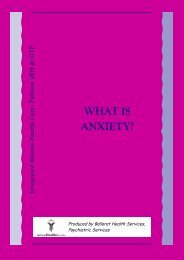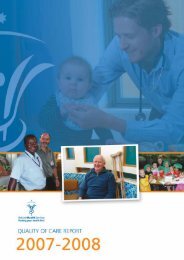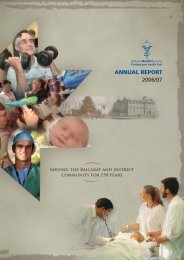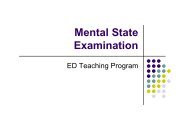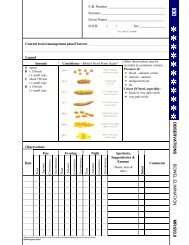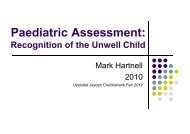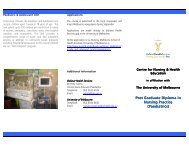Student Orientation Manual - Ballarat Health Services
Student Orientation Manual - Ballarat Health Services
Student Orientation Manual - Ballarat Health Services
Create successful ePaper yourself
Turn your PDF publications into a flip-book with our unique Google optimized e-Paper software.
Undergraduate and postgraduate clinical education orientation package<br />
Appendix D: Immunisation<br />
Allied <strong>Health</strong> and Nursing students fall within either Category A or Category B according to the<br />
Immunisation for health care workers risk categorisation. (Department of Human <strong>Services</strong>, 2006a).<br />
Category A - Direct contact with blood or body substances<br />
This category includes all persons who have physical contact with, or potential exposure to,<br />
blood or body substances. Examples include dentists, medical practitioners, nurses, allied<br />
health practitioners, health care students, emergency personal (fire, ambulance and volunteer<br />
first aid workers), maintenance engineers who service equipment, mortuary technicians,<br />
central sterile supply staff, and cleaning staff responsible for decontamination and disposal of<br />
contaminated materials.<br />
Category B - Indirect contact with blood and body substances<br />
This category includes workers in patient areas who rarely have direct contact with blood or<br />
body substances. These employees may be exposed to infections spread by droplets, such as<br />
measles and rubella, but are unlikely to be at risk from blood borne diseases. Examples<br />
include catering staff and ward clerks.<br />
As a consequence of this risk categorisation, it is clear that certain occupations, particularly health<br />
care workers (HCWs), are associated with an increased risk of some vaccine preventable disease<br />
(VPD) and may transmit infections to susceptible patients, as reported in “Maintenance of<br />
immunity to VPDs in the HCW population helps prevent transmission of VPDs to and from<br />
HCWs and patients” (Department of Human <strong>Services</strong>, 2006a).<br />
It is important, therefore, to ensure that students attending clinical placements at <strong>Ballarat</strong> <strong>Health</strong><br />
<strong>Services</strong> (BHS) understand that they may be exposed to VPD whilst on placement, and have<br />
adequate knowledge about vaccines and diseases to make an informed decision about their level<br />
of immunity prior to attending BHS for a clinical placement.<br />
It is recommended that:<br />
1. <strong>Student</strong>s have the following levels of immunity prior to attending a clinical placement at<br />
BHS. The following recommendations are based on Table 2.3.2: Recommended vaccinations<br />
for those at risk of occupationally-acquired vaccine preventable diseases, pp. 75-76<br />
(NHMRC, 2003) and (Department of Human <strong>Services</strong>, 2004).<br />
• Hepatitis B;<br />
• Hepatitis A (HCWs who work with rural and remote indigenous communities or<br />
paediatric patients from rural and remote indigenous communities);<br />
• Influenza;<br />
• Measles, mumps and rubella (HCWs born during or since 1966);<br />
• Varicella (chicken pox; HCWs who have not previously had chicken pox);<br />
• Pertussis (whooping cough; HCWs in paediatric and maternity departments);<br />
• Tuberculosis:<br />
- Allied <strong>Health</strong> and Nursing staff are within the Medium Risk category for tuberculosis<br />
(Department of Human <strong>Services</strong>, 2006a).<br />
- BCG vaccination is no longer routinely recommended for Victorian HCWs, however<br />
health care facilities should consider offering BCG to HCWs and voluntary workers<br />
who are Mantoux negative, where the risk of repeated exposure to infectious TB is<br />
high and not controlled despite appropriate infection control procedures. Use of<br />
Last updated: 2 nd February 2012 21



